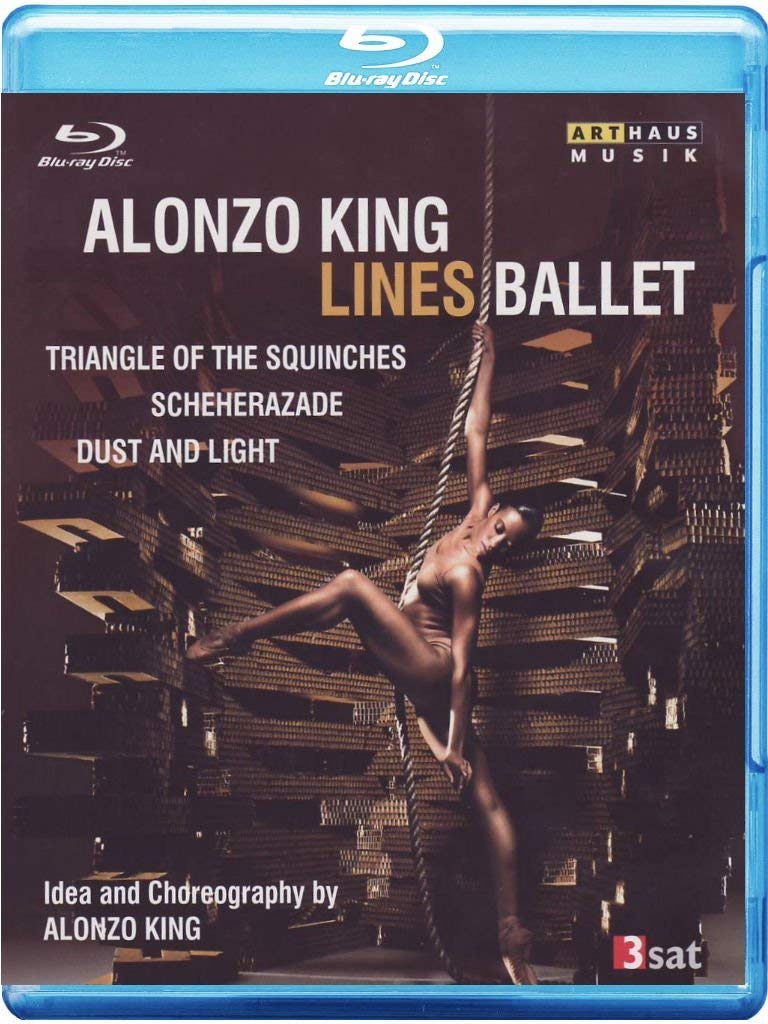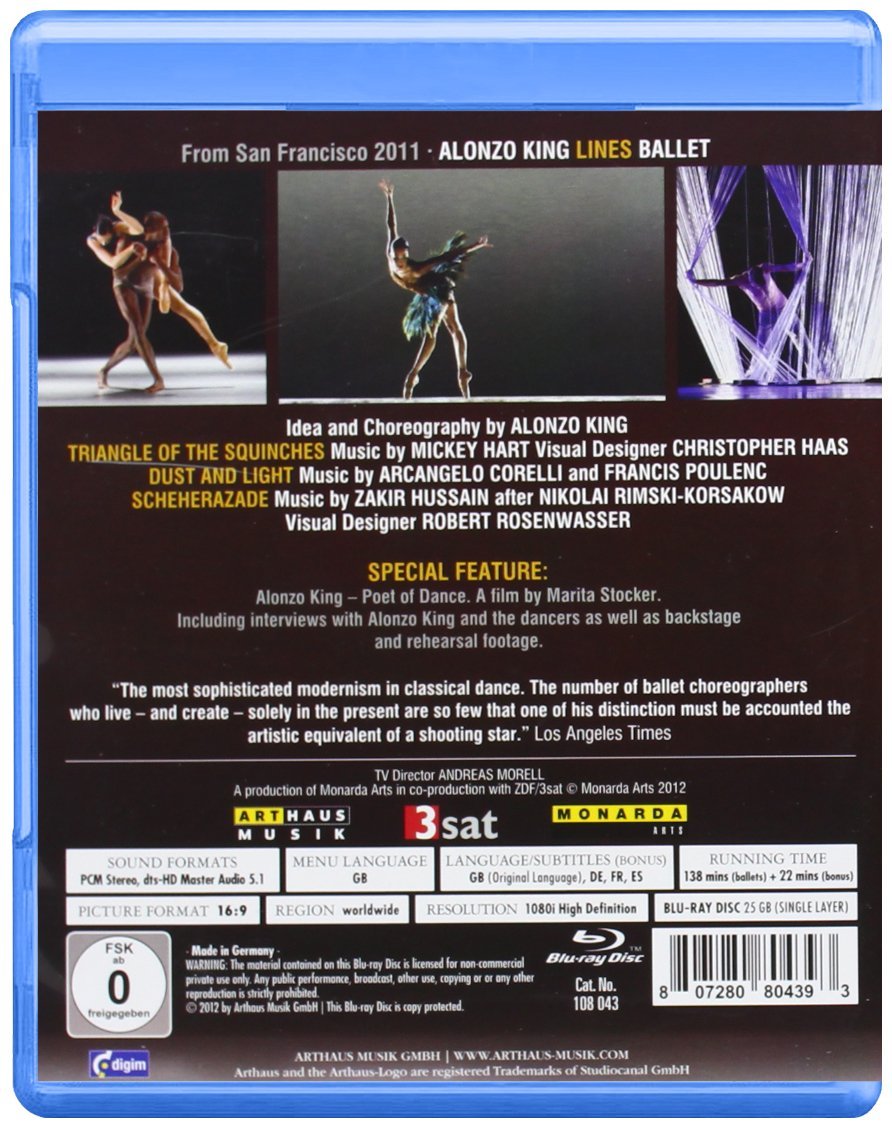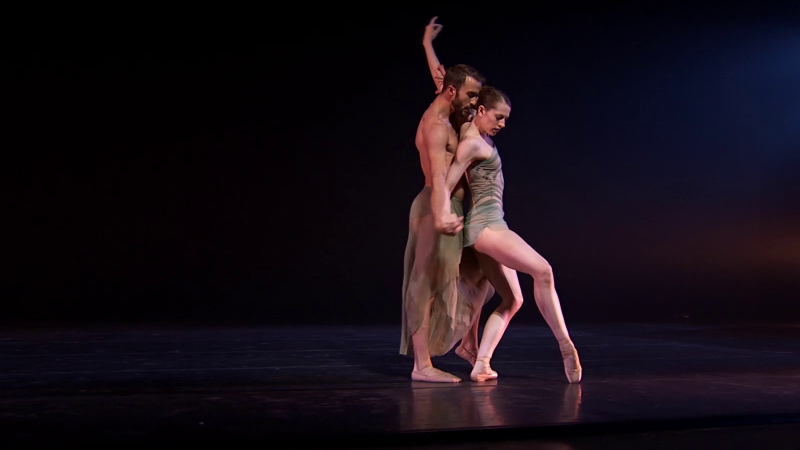

Alonzo King LINES Ballet dance recital. Three studio recordings choreographed by Alonzo King for his LINES Ballet. Performed in 2011 in San Francisco at the Kerner Studios. Stars dancers Victor Mateos Arellano, David Harvey, Courtney Henry, Ashley Jackson, Yujin Kim, Laurel Keen, Michael Montgomery, Caroline Rocher, Zac Tang, Meredith Webster, Keelan Whitmore, Kara Wikes, and Ricardo Zayas. See keep-case booklet for identification of dancers scene-by-scene.
Works featured:
Triangle of the Squinches. Music by Mickey Hart; visual design by Christoper Haas; costumes designed by Robert Rosenwasser and constructed by Joan Raymond.
Scheherazade. Music by Zakir Hussain after Nikolai Rimsky-Korsakov; lighting by Axel Morgenthaler; visual design by Robert Rosenwasser; costume designs by Colleen Quen and Robert Rosenwasser; costumes constructed by Coleen Quen, Joan Raymond, and Abra Berman; production design by Robert Rosenwasser, Axel Morgenthaler, and G. Chris Griffin.
Dust and Light. Music by Arcangelo Corelli and Francis Poulenc; light design by Axel Morgenthaler; costumes designed by Robert Rosenwasser and constructed by Joan Raymond.
Also includes a documentary firm by Marita Stocker called Alonzo King--A Poet of Dance.
Other members of the artistic team receiving credits: technical direction by Tom Cloutier and G. Christopher Griffin; lighting by Meghan Beitiks, Victoria Hendrix, and Dan Kaminski; sound mixing by Claudia Wronski. Directed for TV by Andreas Morell. Released 2012, disc has 5.1 dts HD Master Audio sound. Grade: A-
Alonzo King appears to be a protean force for modern dance in San Francisco. On his website you learn about his many dance studios where anyone can take lessons, his community outreach, and, of course, his elite company. In addition to being an organizational genius, he's something of a philosopher; or at least, he has the gift of gab. On the bonus included on this disc, King comes across as simple and totally sincere. As a choreographer, he is (in his words) a lyricist who writes lines for dancers. Each dancer learns the lines. Then each dancer is expected to create his or her own personal rendition of the lines in an effort to come up with a hit. When the dancer is successful, he or she becomes a "human masterpiece."
Over the years, King has developed a fair number of major pieces. This disc includes 3 of his recent works. These are modern dances based on classical ballet technique. The works are abstract, but the dancers try to drench their moves in emotions, and there may be times when one can detect a theme or guess at some objective meaning in the production. Most of the formality of classical ballet is shuffled off and replaced with liberal, lyrical extensions in dance syntax, personal interpretation and, I think, on-the-spot improvisation. When the entire company appears, they dance in prescribed patterns. Each dancer in each group does something similar to the others, but each has a unique interpretation. There's no effort to achieve the uniformity in execution that's so important to the big ballet houses.
A small company like the LINES Ballet would rarely if ever be able to afford live music. Here all the music is recorded and tends to be as diverse and eclectic as the dancing. I should also say that the sound quality is about as good as 48kHz/dts-HD Master Audio is ever going to be. Compared to what we had on DVD, it sounds terrific.
King's dancers show you the direction the population of the U.S.A. is headed. There are a few whites, a few blacks, and in between 50 shades of brown. I never thought of the U.S. as a "melting pot" (that title belongs to the Mexicans). The U.S. is more of a gigantic tossed salad. But after two or three new generations of King LINES dancers, we will be a khaki country for sure or maybe a shade richer.
The LINES Ballet performs before live audiences all over the world. But the video for this title was specially shot in studio. Each of the three pieces is the subject of a separate film that could be shown individually on TV. From what I saw on the bonus extra, King was there working on every frame with his TV director, Andreas Morell. Most of the dance titles we get are by-products made as a possible additional profit center from live shows before a audience. The TV director does the best he can with limited resources and access to the dancers. But to King, subject title was a major project with the goal of making the best video possible to spread the fame of his group. Below is a shot of the stage King built for recording this title. A rail track runs all the way across the "front" of the stage. A camera on rails, a camera on wheels, and a boom camera shoot simultaneously:
King was rewarded for his efforts with one of the most beautiful video presentations of dancers ever made. Because the cameramen were so close and had the time and gear to do it right, resolution and depth of field-of-focus are probably at laboratory limits of perfection. The lighting was expertly arranged to give a three-dimensional look to bodies of the dancers in the close shots. When the company is on stage, the cameras pull back to reveal the whole show. The costumes are clean and simple but exceptionally beautiful in design and construction.
So the video is exceptionally good. I know of no legacy movie film to mention here other than the Amelia film from Édouard Lock. But that film was made with processing of the image for a special look. Nor could anything on VHS, laser disc, or DVD even enter consideration. Of course, we have a number of great HDVDs of the big ballet houses in famous works like Swan Lake, Giselle, as well as new works like the Little Mermaid. All of these films deal with big challenges---but none of them has intimate video with the beauty and clarity achieved by King and Morell. We have a fine Siddharta modern ballet, but that video was shot live and required mostly full stage shots. The Caravaggio title from the Berliner Staatsballett is competitive and I'll give it the honor of being one of the best for showing beautiful images of the human body. And guess who was the the TV director for Caravaggio? You're right---it was in fact the same Andreas Morell who shot our LINES Ballet disc!
Of the 3 pieces on this disc, I liked Scheherazade and Dust and Light the best. Here are a few screenshots to whet your appetite. My overall favorite shot is the one that follows of Ashley Jackson in Dust and Light:
The rest of the shots below are from Scheherazade. This opens with a sultry duet between Yujin Kim and David Harvey in the role of Shahryar:
Here's a rope duet with David Harvey as Shahryar and Lauren Keen as Scheherazade:
Ashley Jackson again looks fantastic in a peacock tutu made by Abra Berman:
A long and intense duet between David Harvey as Shahryar and Laren Keen as Scheherazade (4 shots):
A small part of the company (it's hard to get a screen shot of this whole company without motion blur):
The Triangle of the Squinches title is not quite as successful as Scheherazade and Dust and Light. A squinche is, per my dictionary, in architecture "a construction filling in the upper angles of a square room so as to form a base to receive an octagonal or spherical dome." H'm. I thought maybe this word developed on the street independently of classical buildings. But then I discovered that the set designer, Christopher Haas, is a famous architect. Puzzle solved: the name of this work isn't jive talk---it's ordinary pseudo-intellectual palaver.
Alas, the Haas designs inject prop problems into the video. First, there's a wall of flexible white cords (more lines?) against a dark background. This might look great live, but it's murder to video cameras. Haas also comes up with another wall that is pictured on the artwork on the keep-case. I have a door mat in my garage (made of recycled automobile tires) that is built the same as this prop. Haas intended for this wall to look foreboding and worthy of contending with and overcoming. Maybe it gave that impression to a live audience. But to the high-def camera, it just looks like the flimsy, provisional, and now shopworn cardboard model that it is.
And now for a grade. This is not as "important" a title as the great ballets we are getting from the big houses in Europe and even the San Francisco Ballet. But it's evidence of an impressive story. A black kid likes to dance. He decides to devote his life to his art. What are the odds? Bad. But he has succeeded, and now he has a video that belongs on the same shelf, for it's own reasons, with the best from the Paris Opera, Royal Opera, and San Francisco ballets. I give an "A" to Scheherazade and Dust and Light, a "B to Triangle of the Squinches, and arrive at a "A-" grade for the title.
I'll also brag a bit here about the "role" the HDVD may be playing here. You've heard about guerilla marketing. I doubt that I would have ever heard of the Alonzo King Lines Ballet before HDVD came along. I know little about the ballet world, and when will Alonzo come to Dallas again? But now for $35 I can see his spectacular work anytime. There are small ballet companies working all over the world, and many of them are capable of coming up with a hit. When they do, HDVD gives them a way to share that hit with the world.
OR










